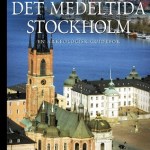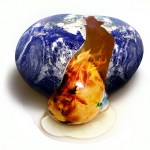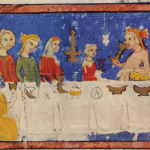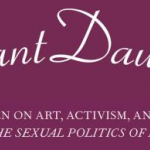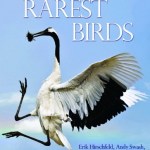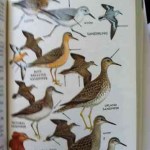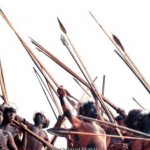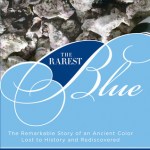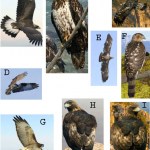Books
About the time of Alexander the Great in the 4th century BC, Greek writers started to offer lists of Seven Wonders that the well-read traveller should see. In the 2nd century BC the Hanging Gardens of Babylon began to show up on such lists. The location of Babylon is well known: on the River Euphrates in southern Mesopotamia. But no ruins of the Hanging Gardens have been convincingly identified there. This is because the gardens were actually in another city in another country, according to Stephanie Dalley's new book, The Mystery of the Hanging Garden of Babylon. The Greeks got the city…
Here's a fun case of me not anticipating an imminent technological development, not thinking that last centimetre of far enough. In July of 2007, six years ago, I wrote:
Lately I have come to think of books as computer devices, combining the functions of screen and backup medium. All texts these days are written and type-set on computers, so the paper thingy has long been a secondary manifestation of the text. People like publisher Jason Epstein and book blogger the Grumpy Old Bookman have predicted that we will soon have our books made on demand at any store that may today have a machine for…
Gang, don't try this at home. I'm a trained professional, so I can get away with it, although I do face extreme risk of brain damage.
I am reading two books at once. OK, that part isn't too scary, I'm actually just alternating between the two — an hour with one at lunch time, an hour or two with another before bed. I trust you all are able to do this, no problem.
It's the pairing that is the killer. In one corner, I'm reading the marvelously detailed, juicy, thought-provoking The Cambrian Explosion: The Construction of Animal Biodiversity by the highly regarded scientists, Erwin and Valentine…
Lehrer has landed a new book deal. This has sparked justifiable disgust: Maria Konnikova explains why.
Lehrer is not the writer who simply made up a few Bob Dylan quotes and self-plagiarized (the way he’s portrayed in recent accounts of his latest book deal). He is the writer who got the science wrong, repeatedly, who made up facts, misrepresented information, betrayed editors, and lied, over and over and over again, for many years, in multiple venues, not just in a single book. He is, in other words, the writer and journalist who went against the basic tenets of the profession, and did so…
Historiska media is a publishing house in Lund. In recent years they have been putting out pop-sci guide books about Medieval Sweden, province by province. I've reviewed the volumes about Södermanland and Uppland provinces here. And now my friend and Fornvännen co-editor Elisabet Regner has written the first volume in the series that deals with a town, not a province: about Stockholm, in whose suburbs I've lived for almost all my life. Together with the Uppland and Södermanland volumes, Det medeltida Stockholm gives us Stockholmers a pretty good grip on our Medieval surroundings.
I shouldn't…
There is a book called "The Mad, Mad, Mad World of Climatism: Mankind and Climate Change Mania" produced by the Heartland Institute. The Heartland Institute is famous for doing all that work to prove that smoking is not bad for you, and more recently, that climate change is not real or is not important or is not human-caused etc. etc. Heartland is a libertarian "think" tank that receives money form big corporate interests like Tobacco and Petroleum and then uses that money to advance the interests of those corporate entities, regardless of the actual truth of the situation. They also use…
I rarely review fiction, but I've got a nice book I'd like to recommend. My friend Amy suggested it to me on facebook a while back when I was casting around for a novel to read. The novel is People of the Book by Geraldine Brooks.
INTERNET WARNING: THIS BOOK IS LIKE FIVE YEARS OLD I DON'T CARE
Although a lot of people made a wider range of suggestions on my facebook post, I knew that when I saw Amy's suggestion it was the one I should try. She knows enough about me (we worked together for a few years) to zero in on something that I would appreciate, and she's a person who understand…
Usually I don't mention books unless I've read them, but I thought a lot of my readers would be interested in a volume I have only heard about: Defiant Daughters: 21 Women on Art, Activism, Animals, and the Sexual Politics of Meat.
Here is the description:
When The Sexual Politics of Meat: A Feminist-Vegetarian Critical Theory by Carol J. Adams was published more than twenty years ago, it caused an immediate stir among writers and thinkers, feminists and animal rights activists alike. Never before had the relationship between patriarchy and meat eating been drawn so clearly, the idea that…
There are something over 10,000 species of birds (thus the name of the famous blog). Of these, just under 600 are in very very serious trouble, some to the extent that we are not sure if they exist, others are so rare that we know they exist but there are no good photographs of them, others are merely very likely to go extinct. There are patterns to this rarity, having to do with what threatens birds on one hand and what makes certain birds vulnerable on the other, but the range of birds that are threatened, in terms of size, shape, kind of bird, habitat, etc. represents birds pretty…
A couple of years back, the The Crossley ID Guide for Eastern Birds came out and it caused a huge splash in the birdwatching world. For some time now it has become apparent that bird watching, especially the identification part of it, was changing in its approach. We describe it this way, though I think the reality is more complex: In the old days we used logical links to known reliable field marks to turn carefully made field observations into species identifications of varying degrees of certainty. Now, a new approach has been developed where we look at the whole bird and get an…
Napoleon Chagnon spent years living among the Yanomamo of Venezuela and wrote, among other things, a classic ethnography still used widely in anthropology classes. It came to pass that Chagnon and his ethnography came under scrutiny, actually a few waves of scrutiny, from practitioners of cultural anthropology in part because his monograph depicted the Yanomamo as “fierce people” and this characterization of them was used, misused really, against them by outside forces including the government to justify their “pacification.” The Yanomamo were indeed being abused by these outside forces, and…
In this well-written, painstakingly annotated and beautifully designed book, physicist Baruch Sterman (with contributor Judy Taubes Sterman) traces the history and prehistory of a certain blue pigment, along with its cultural and religious significance through the ages. It's what the Torah and Talmud calls tekhelet, and it's made from a gland harvested from Murex sea snails.
Though greatly interested in history, archaeology and biology, I find myself poorly equipped to engage with the book's subject matter. Or put differently, I don't think I'm part of its intended audience. Because there's a…
Kay Glans used to edit the literary pages of Svenska Dagbladet, Sweden's main conservative* newspaper, and Axess Magasin, a conservative Swedish arts & social sciences mag that also has a TV channel. The latter's standard is high, and I've been particularly pleased to find repeated staunch rebuttals of post-modernism there. What I don't like much in Glans's oeuvre is a tendency for aesthetic idealism and aesthetic conservatism, of the canon-stroking sort. His writers tend to believe that there are classics that every educated person should read. I'm an aesthetic relativist and accept no…
As you may or may not know, I'm currently at work on a book called How to Think Like a Scientist. This raises the fairly obvious question in the post title, namely, why should people think like scientists? What's the point?
In a sense, this is (as Ethan Zuckerman pointed out at lunch the other day) the underlying question at the heart of the whole endeavor of science communication. I mean, I've written two books about modern physics for a general audience, and when I have time, I write this blog aimed at non-scientists. What's the point of doing all that, anyway? What is it I hope to achieve…
You’ve heard of the The Crossley ID Guide: Eastern Birds (The Crossley ID Guides). It is a revolutionary new way to assemble a field guide, where each page has a drawing of what it would look like if suddenly outside your living room there was a full blown habitat for some species of bird, with individuals from that species flying or sitting all over the place in different positions, doing different things, and at different distances. These pages in the field guide almost give you the experience of having seen many of this partiuclar species of bird, like you were suddenly an experienced…
The Grey Mouser, along with Fafhrd the Northerner hero of Fritz Leiber's genre-defining sword & sorcery story cycle, is the archetype of the Dungeons & Dragons thief. He began his career however, Leiber informs us, as apprentice to a "hedge-wizard" who taught him some simple magical cantrips. I never understood what a hedge-wizard was, until now. I imagined it had to do with living in a squalid cottage out in the fields and being in touch with nature, druid-like.
Reading Avram Davidson's story "The King Across the Mountains", I now came across a hedge-parson. And googling, I found out…
The Crossley ID Guide: Raptors is just now coming out. I was able to spend a little time with it a few weeks ago, though my official copy has not arrived yet. But Princeton (the publisher) is organizing a major blog hoopla over the publication of this new book, and I've signed on to participate. Starting yesterday a number of bird-related blogs are producing posts related to this book. My post comes out next Tuesday and it will consist of a quiz, a bird quiz. Anyone who gets the quiz right will be eligible for random selection, and whoever gets randomly selected will be hooked up with…
Several thousand scientists at a handful of different research centers spent a gazillion hours and a huge pile of money searching for the Higgs Boson. But, nobody really cares that much about the Higgs Boson. The important thing is the Higgs Field. The Higgs Field is this thing that is everywhere, as these spooky quantum fields tend to be, but that has a strange characteristic that makes it different from other fields; at rest the Higgs field has a non zero energy level. This means that its effect on particles is asymmetric. What that means is that when you write a mathematical formula of…
Climate Change Science: A Modern Synthesis: Volume 1 - The Physical Climate is a new book you may be interested in, authored in part by my friend John Cook of Skeptical Science. Importantly, the project deals not only with climate change, but also, with important aspects of the politics of climate change and with climate change denialism:
The textbook is written for the introductory science student at the undergraduate college level. We describe the discipline of climate change science, and individual climate scientists whose expertise spans Earth history, geology, geography, biology,…
People who do a lot of field work end up with interesting stories to tell, especially if the fieldwork is diverse and the conditions are adverse. Often, the sort of thing people want to know about is very different from the repertoire of available stories, but as long as the expectations of the audience is not too rigid, experienced fieldworkers in the various sciences that do field work make the best cocktail party extras.
I never met Jon Kalb, but we have a lot of colleagues in common. I first heard of him as one of the scientists on the same expedition that found the famous fossil "Lucy…

